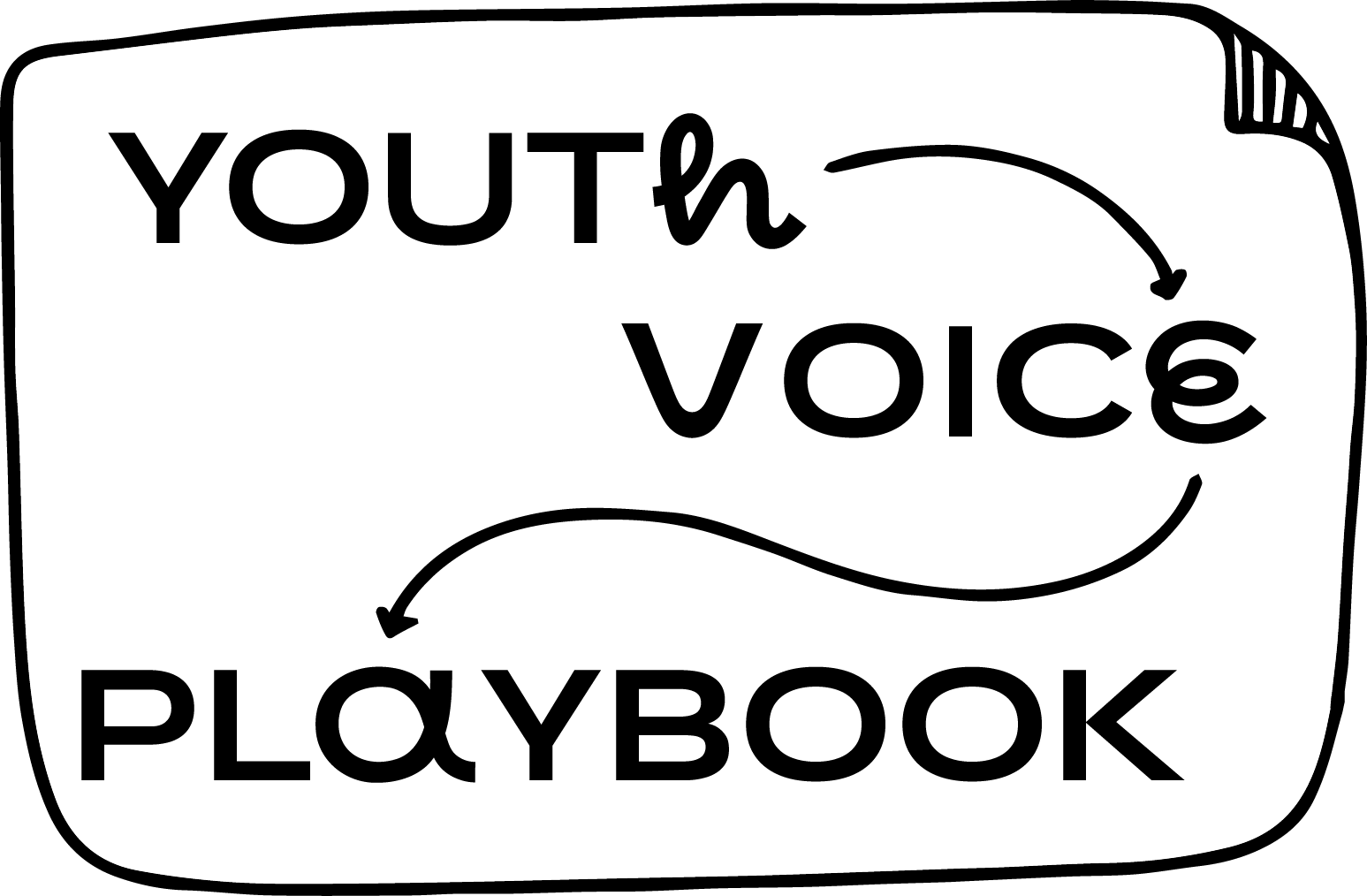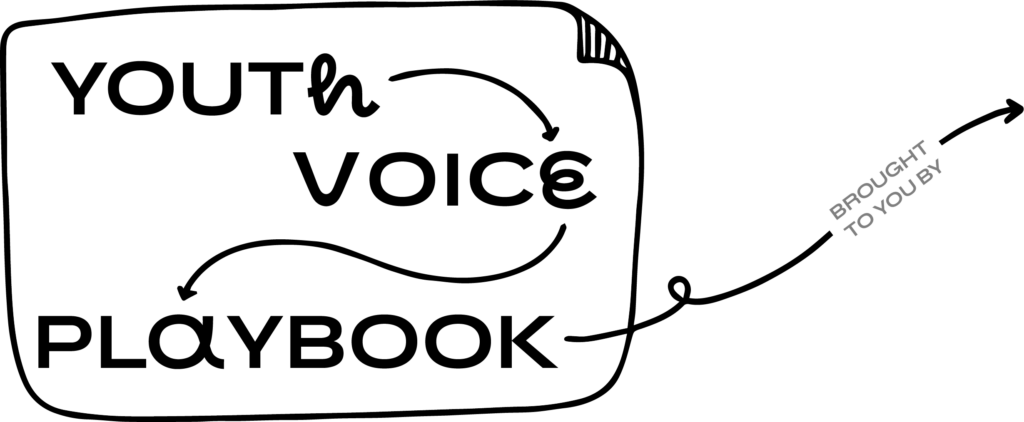Youth voice is a game-Changer.
The Youth Voice Playbook is a free resource collaboratively produced by three organizations: the Center for Digital Thriving, Hopelab, and Character Lab. We created it because we want to help build a future where all young people can thrive – and to make that happen, we know young people’s voices need to be heard, their experiences understood, and their ideas elevated. We also know that a lot of people who share this core belief aren’t sure where to start or how to meaningfully build youth advisory into their work. If you’re one of them, consider this Playbook your all-in-one guide to everything from planning and recruitment to our favorite activities for exploring young people’s perspectives and then making sense of what you’ve learned. The Playbook shares usable resources, honest insights, and real stories. It’s designed to help, and packed with information that we wish someone had shared with us as we all started engaging youth in our own workstreams.
Preparing Yourself
How you show up in this work is foundational.
Start here!
Read this section if you’re an adult who has ever thought something along the lines of “kids these days… (smh).” Or maybe you want to involve youth in your research, but don’t know where to start. This is the place!
Ethics & Laws
Involving youth in research is really valuable, but it also requires a lot of care.
For good reason, minors are highly protected when they’re involved in research activities. You’ll need to make sure you’re familiar with the regulations in place to protect their well-being and that you have a green light from relevant governing bodies.
Budgets & Resources
Before you start inviting youth to join you in your project…
…think through both how you’ll make it logistically feasible for them to come (they can’t just skip school to join you!) and how you’ll make it worth their time, both figuratively and literally. This chapter covers financial and human resource considerations, including compensation.
Recruitment
Sounds simple, right? Hahaha! 🙂
This chapter focuses on how to actually find young people and invite them to join you in your project!
Designing Activities
This chapter is a gold mine! It has so many cool activity ideas!
Even if you think you already know what you want to do with your group’s time and how you want to actually collect information from youth, you’ll want to check this one out.
Facilitation
Figuring out how you want young people to feel and contribute…
…is a key place to start. This chapter will guide you through ways to set the tone, and then how to maintain that tone throughout the actual gathering. Good facilitation is a real skill and art, and every group – heck, every moment! – is different, but this will give you a place to start.
Documentation & Reflection
How will you summarize what you learned?
This section shares practical advice on capturing what happened during your time with youth.
Making Sense of the findings
Now we’ll shift to that key step of making meaning.
Sense-making may happen near the end of the project or it may happen iteratively, but regardless, we’ll focus specifically on involving young people in this process.
Closing & Sharing
Regardless of how young people are involved…
…it’s important that they hear in some way about what happens as a result of their input and expertise. This chapter shares ways to do that meaningfully, including how you might involve youth in publication, presentation, and dissemination of results.
Among the many benefits of bringing youth voices to the fore:
Who This Playbook is For:
The short answer is anyone who is doing research that impacts youth!* This might be traditional academic research, user research, or research & development work. Regardless of the type of research you’re doing, we hold a fundamental belief that youth should be involved in research about the issues that impact them – and that the work is stronger when young people shape it. In the words of many other movement leaders, “Nothing about us without us!”
Why create a playbook now?
“Youth voice” is trending. On the one hand, this is amazing! But on the other hand, we know that doing this authentically and well takes a lot of work. Youth participatory methods are an important way to amplify youth voice and agency in matters that impact them (United Nation Convention on the Rights of the Child, 1989), but also require facilitators to create conditions that allow for genuine learning, empowerment, and input. This playbook is here to help you do just that.
A note from the authors:
We hope that this playbook can provide inspiration, food for thought, and some practical guidance for researchers, non-profit leaders, funders, program staff, and anyone else who knows that they have much to learn and gain from working more closely with young people.
Some parts of this playbook, especially chapters 2 and 3, might feel daunting. That’s ok! It’s true that doing research with minors involves a number of complexities that often scare people off. We’re here to walk you through those complexities and share all the tips and lessons we’ve learned along the way. Also, you should know that there are organizations that exist to help facilitate the tricky parts of this process for you, so you can focus less on logistics and more on research. We’ll share some of those examples throughout this playbook.
Youth voice has been critical to our own work. Young people’s perspectives have helped us realize who we were unintentionally excluding, when we were missing the mark, and when we weren’t thinking deeply or complexly enough about an issue. Engaging with youth voices has helped us see totally new ideas, stay nimble and creative, and develop the skill of working intergenerationally. It’s also been a good reminder to take ourselves less seriously. We hope you’ll join us in this approach of partnering meaningfully with young people to do research – we really think it’s worth it.
In their Words:
Thanks for checking out this playbook! We’d be remiss to not share a few quotes from some students in the CLIP program who reviewed this playbook:
We hope that these sentiments also ring true for you – that as you explore this model of doing research in your organization, you’ll find this playbook to be an enjoyable and positive companion. We believe that youth voice should be taken seriously, prioritized, and invested in, and we wish you all the best on your journey of collaboration with young people! May it bring you as much insight, growth, and joy as it’s brought us.
Get in the game →
Prepare yourself to show up to this work.
Need help figuring out where to start?
Try our decision-making flowchart to help you figure out where to dig in and what you can maybe skim over. 👇
Tell Me More…
For alL who’ve just begun, we recommend Chapter 1!
Yes, for sure!
Keep Scrolling
Not Yet…
Never Fear, chapter 2 is here!
Yep.
Keep Scrolling
Say more…
Chapter 3’s the place to be!
Yes!
Keep Scrolling
No, I already have a group.
Learn More in Chapter 4!
Yes!
Keep Scrolling
Not yet…
Our favorite activities…
Yes, I’m set.
Keep Scrolling
Unsure…
Lotsa Tricks in Chapter 6!
Yes!
Keep Scrolling
Not exactly…
Need support? Chapter 7’s got your back!
Yes!
Keep Scrolling
Tell Me More…
Chapter 8’s great for this.
Yes!
Keep Scrolling
Not yet…
Collab and shine in chapter 9!
Yes!
Keep Scrolling
Yes!
Back to the beginning for the next round!
Super Yes!
Back to the Beginning for the next round!
* We’re intentionally not defining youth, because each reader’s audience is likely different. Suffice it to say, we’re talking about people in late childhood, adolescence, and early adulthood, who are often the “beneficiaries” of programs that they don’t get to help design. Typically this might mean somewhere around ages 12-20, but many of the things we discuss in this playbook can also be applied to younger or older audiences.
































